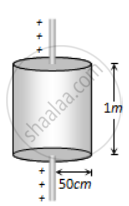Advertisements
Advertisements
Question
Choose the correct option.
An electron is placed between two parallel plates connected to a battery. If the battery is switched on, the electron will
Options
be attracted to the +ve plate
be attracted to the -ve plate
remain stationary
will move parallel to the plates
Solution
An electron is placed between two parallel plates connected to a battery. If the battery is switched on, the electron will be attracted to the +ve plate
APPEARS IN
RELATED QUESTIONS
Mark out the correct options.
A proton and an electron are placed in a uniform electric field.
The electric force experienced by a charge of 1.0 × 10−6 C is 1.5 × 10−3 N. Find the magnitude of the electric field at the position of the charge.
Choose the correct option.
A charge of + 7 μC is placed at the centre of two concentric spheres with radius 2.0 cm and 4.0 cm respectively. The ratio of the flux through them will be
Choose the correct option.
Two point charges of +5 μC are so placed that they experience a force of 8.0 × 10-3N. They are then moved apart so that the force is now 2.0 × 10-3N. The distance between them is now
One metallic sphere A is given a positive charge whereas another identical metallic sphere B of exactly the same mass as A is given an equal amount of negative charge. Then
When 1019 electrons are removed from a neutral metal plate through some process, the electric charge on it is ______
Two small conducting spheres of equal radius have charges +10 µC and -20 µC respectively and placed at a distance R from each other experience force F1· If they are brought in contact and separated to the same distance, they experience force F2. The ratio of F1 to F2 is ____________.
A conducting sphere of radius 0.104 m has an unknown charge. If the electric field at 0.20 m from the centre of the sphere is 1.5 x 103 NC-1 and points radially inward, what is the electric flux?
Electric charge is a property of ______.
Electric charges are of ______.
Assertion: The positive charge particle is placed in front of a spherical uncharged conductor. The number of lines of forces terminating on the sphere will be more than those emerging from it.
Reason: The surface charge density at a point on the sphere nearest to the point charge will be negative and maximum in magnitude compared to other points on the sphere.
Electric charge is uniformly distributed along a long straight wire of radius 1 mm. The charge per cm length of the wire is Q coulomb. Another cylindrical surface of radius 50 cm and length 1 m symmetrically enclose the wire as shown in the figure. The total electric flux passing through the cylindrical surface is ______.

Electric field lines provide information about ______.
Two charges q1 and q2 are placed in vacuum at a distance d and the force acting between them is F. If a medium of dielectric constant 4 is introduced around them, the force now will be ______.
A positive charge particle of 100 mg is thrown in opposite direction to a uniform electric field of strength 1 × 105 NC–1. If the charge on the particle is 40 μC and the initial velocity is 200 ms-1, how much distance it will travel before coming to the rest momentarily ______.
A certain charge Q is divided into two parts q and (Q - q). How should the charges Q and q be divided so that q and (Q - q) placed at a certain distance apart experience maximum electrostatic repulsion?
Two identical metallic spheres A and B when placed at certain distance in air repel each other with a force of F. Another identical uncharged sphere C is first placed in contact with A and then in contact with B and finally placed at midpoint between spheres A and B. The force experienced by sphere C will be:
A straight infinitely long cylinder of radius R0 = 10 cm is uniformly charged with a surface charge density σ = + 10-12 C/m2. The cylinder serves as a source of electrons, with the velocity of the emitted electrons perpendicular to its surface. Electron velocity must be ______ × 105 m/s to ensure that electrons can move away, from the axis of the cylinder to a distance greater than r = 103 m.
The electrostatic potential inside a charged spherical ball is given by `Phi = ar^2 + b`, where r is the distance from the centre a, and b are constants. Then the charge density inside the ball is ______.
The potential at a point x (measured in µm) due to some charges situated on the X-axis is given by v(x) = `20/((x^2 - 4)` V. The electric field E at x = 4 µm is given by ______.
